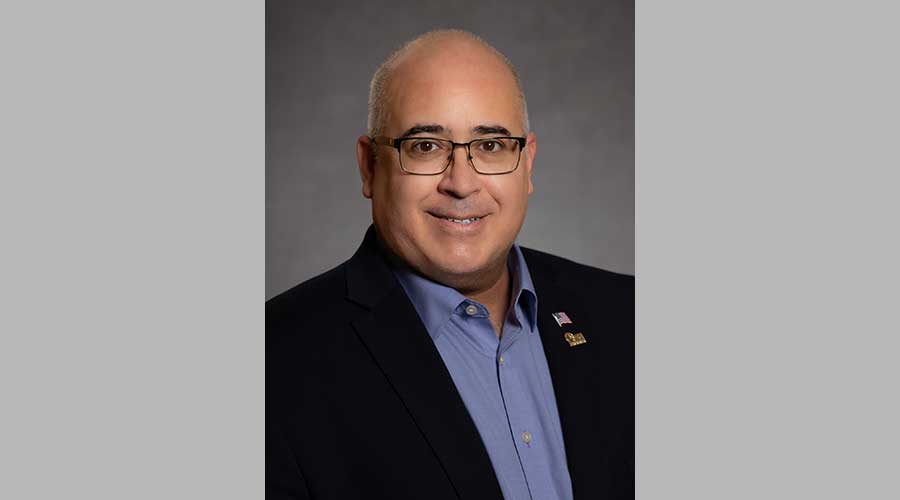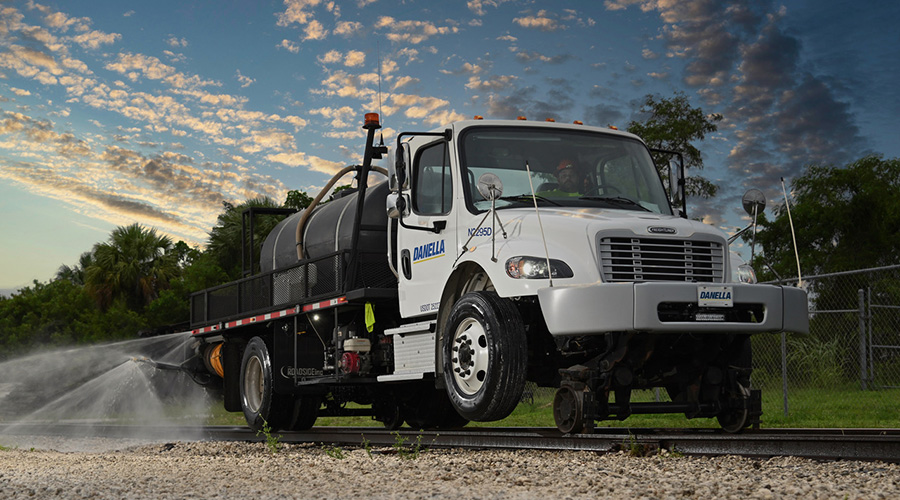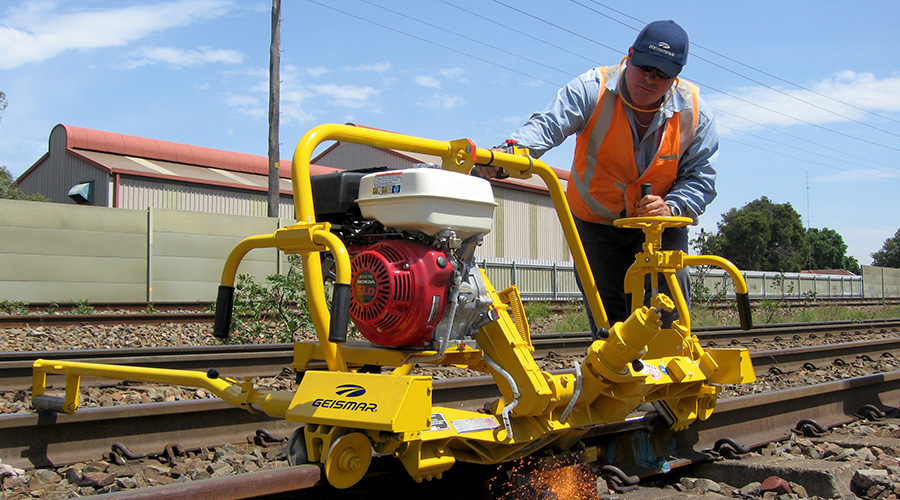Stay updated on news, articles and information for the rail industry
October 2015
Rail News: MOW
Wood-tie producers, treaters gear up for sunnier market prospects
By Michael Popke

Shown: Wood ties on the bridge were treated with Arch Wood Protection Inc.'s ammoniacal copper zinc arsenate product Chemonite®.
Five words sum up the wood crosstie market during the past couple years: “When it rains, it pours.” The old phrase took on new meaning for manufacturers and wood-treatment companies, as some of the wettest weather in years flooded large swathes of the southern and western United States, resulting in waterlogged wood supplies and derailed inventories.
“The good news is that inventories are pretty much back to normal,” says George Caric, vice president of marketing for wood-tie producer Stella-Jones Inc. “I’ve been in the business for 35 years and never saw weather that bad. We appreciate customers’ patience.”
In the meantime, Stella-Jones is focusing on fulfilling existing orders that had been delayed because of the weather and is buying twice as much wood to replenish its inventory, says Caric, adding that the company is “in good shape” for 2016.
During the past six months, more wood has become available as “the South has dried out,” says Michael Pourney, president and chief executive officer of Gross & Janes Co., a supplier and shipper of wood ties.
“I’m optimistic that we’ll catch up and return to previous procurement and production levels,” he adds. “Things will get back to normal after being out of whack for the past 24 months.”
A little normalcy would go a long way. For most of 2013, all of 2014 and part of 2015, the wood crosstie industry — which represents more than 93 percent of the market for overall tie purchases in North America — struggled not only with excessively wet weather, but with competition for hardwoods used in housing and other industries, rising raw wood prices and higher demand for exports.
“Production has been on an upswing in the East for most of the year, and as weather improved in the West, we saw similar improvement as log decks increased,” says Railway Tie Association (RTA) Executive Director Jim Gauntt. “In some regions — mostly eastern [U.S.] plants — the ability to start improving white tie inventory so that air-dry tie inventories will be sustainable by late spring next year is looking probable. In other regions, wet weather has hampered building the air-dry stacks.”
In those areas, production plants appear to be several more months away from sustainable air-dry inventory, Gauntt says.
In July, wood-tie production fell 8.3 percent to 2.4 million units and purchases rose 5.4 percent to 2.4 million units from June levels, according to RTA data. Compared with year-ago levels, both production and purchases were up in July, the latest month for which figures were available as of press time. Production soared 34.2 percent and purchases climbed 5.3 percent. For 2015’s first seven months, production rose 32.1 percent and purchases were up 4 percent compared with totals during the same 2014 period, according to RTA.
Meanwhile, the supply of raw material has surged so far this year after two dismal production years, says John Giallonardo, vice president of Class I sales and North American operations for wood-tie producer Koppers Inc.
“Getting past the challenges the weather posed in some regions has been, and continues to be, the hardest row to hoe,” RTA’s Gauntt adds. “There is a lot of optimism, though, that the situation is improving enough to feel as if the industry has regained its footing and demand will be met.”
One reason for the optimism: Demand for wood ties, particularly from freight railroads, has remained steady. Class Is “seem to have made the determination that strong, steady maintenance, as well as targeted new construction, is the optimal approach for ongoing tie programs,” Gauntt says.
“The age of the infrastructure at railroads, just like everything else, is getting older,” adds Tim Carey, industrial products specialist at Arch Wood Protection Inc., which treats wood used for railway ties.
And purchasers want ties that last longer. To that end, Arch Wood’s ammoniacal copper zinc arsenate product — sold under the Chemonite® name — is formulated to provide long-term protection while serving as a renewable resource, and providing low-energy production and carbon sequestration.
Wood treatment specialists
Tie producers, too, have kept treatment top of mind. Through a partnership with Kop-Coat Wood Protection Products, Koppers years ago developed Tru-Core®, a borate treatment process that provides interior protection for ties, while Koppers’ Creosote Petroleum Solution creates a barrier to external elements, Giallonardo says.
Meanwhile, Gross & Janes is settling into a new $2.2 million crosstie product and borate treatment facility that opened last year in Camden, Ark. The company selected the Camden location for its logistical advantages — it serves the tie needs of three Class Is. Plus, southern Arkansas boasts some of the best oak timber in the United States and is home to plenty of productive sawmills, Gross & Janes’ Pourney says.
Most ties processed at the Camden facility are Gross & Janes’ borate pre-treated crossties called Tuff-TieTM — a “green” product treated with borate using a non-pressurized process prior to drying and shipped to the customer for creosote treatment. The process eliminates the cost of a pressurized application of borate at the time creosote is applied, while offsetting the amount of oil-based creosote needed for tie protection.
Borate dual treatment of ties is becoming standard practice, says Kevin Kirkland, president and chief executive officer of Nisus Corp.
The company reports “significant demand” among the Class Is for its Cellutreat Liquid DOT Borate and its QNAPTM copper naphthenate wood preservatives. QNAP, which offers “clean handling characteristics” and is “less slippery when wet,” also is becoming popular for use on bridge ties, according to the company.
“Ties are dipped in the borate solution prior to air drying to eliminate incipient decay prior to over-treatment with creosote or QNAP copper naphthenate,” Kirkland says. “QNAP has seen double-digit growth in use as a bridge tie and timber treatment in 2015, and we expect even larger growth in 2016.”
Nisus’ BTX System adds Cellutreat DOT Borate to bridge ties, which can cost up to 10 times more to replace than a crosstie. Some Class Is are expressing interest in applying the technology to their bridge timbers, says Ken Laughlin, vice president of Nisus’ wood preservation division.
“The addition of dual treatments with borates has been a monumental shift within the industry, which will lead to significantly greater tie life for all the roads,” Kirkland says, adding that most of the company’s recent product developments have come from working in partnership with Class Is.
Railroads placing tie orders earlier
Dual wood tie treatment with creosote and borate will extend the average life of wood ties from 35.2 years to more than 40 years, which would lead to savings in the billions of dollars over time, according to a 2011 report submitted to RTA by Zeta-Tech Consulting, a division of Harsco Rail.
“The healthier and greener the railroads are, the better the wood-tie industry’s prospects are for the future,” Gauntt says.
The severe weather of the past two years demonstrates that inventories can’t be taken for granted — and railroads are taking heed, even as conditions improve, says Stella-Jones’ Caric, who notes that many of them now are placing orders earlier in the event that weather wreaks havoc on dry wood supplies.
“It used to be that you could call and order 10,000 ties, and there would be enough wood available to cover an order of that size,” Caric says. “Now, the railroads that buy a lot of different ties for a lot of different properties are moving sooner. ... The situation over the past two years has gotten people to plan ahead.” n
Michael Popke is a Madison, Wis.-based freelance writer. Email comments or questions to prograil@tradepress.com.


 2025 MOW Spending Report: Passenger-rail programs
2025 MOW Spending Report: Passenger-rail programs
 Gardner steps down as Amtrak CEO
Gardner steps down as Amtrak CEO
 Guest comment: Oliver Wyman’s David Hunt
Guest comment: Oliver Wyman’s David Hunt
 Women of Influence in Rail eBook
Women of Influence in Rail eBook
 railPrime
railPrime







